Extraction and structural determination of pectin from pumkin Cucurbita moschata
Pectin is a heterogeneous complex polysaccharide found in the primary cell wall of most cells. In this work, lowmethoxyl pectin was extracted from pumpkin (Cucurbita moschata). The obtained pectin was characterized by GPC
FTIR and NMR spectra. The obtain results showed that structural feature of the pectin is a main chain of poly-α(1→4)-
D-galacturonic acid and occasionally interrupted by α(1→2)-linked α-L-rhamnopyranose residues and branches Galp
is linked to GalpA at C-2 position.
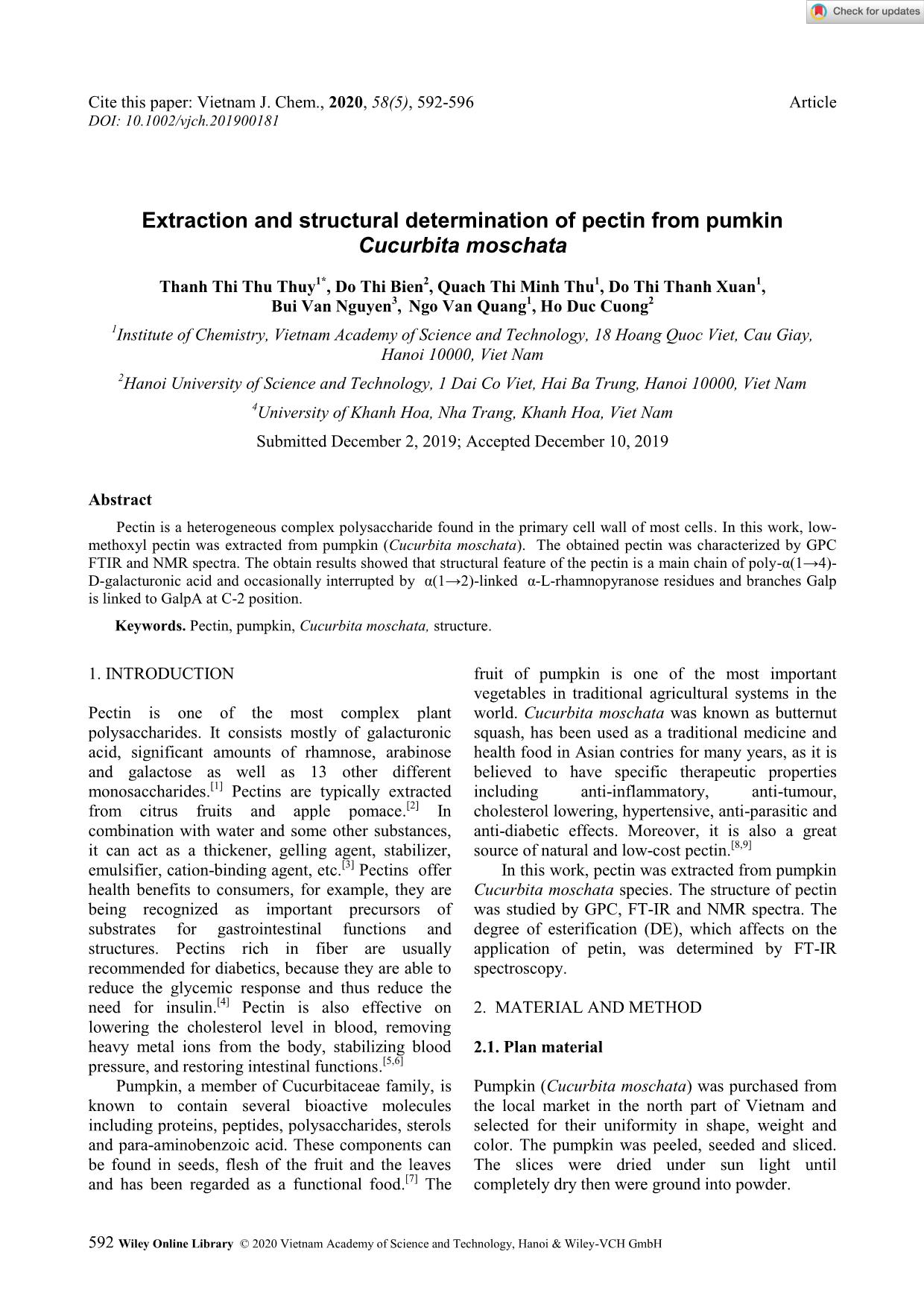
Trang 1
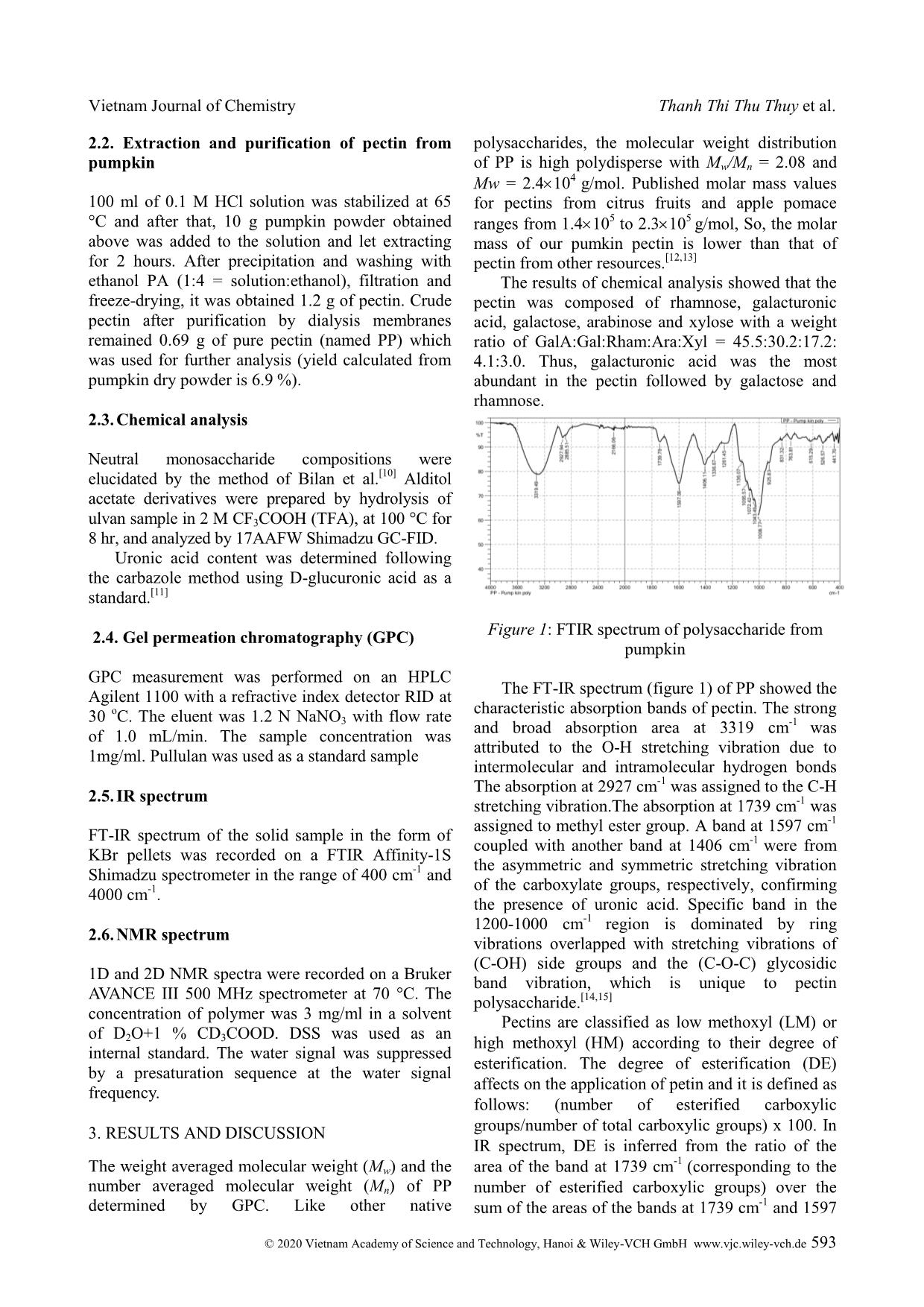
Trang 2
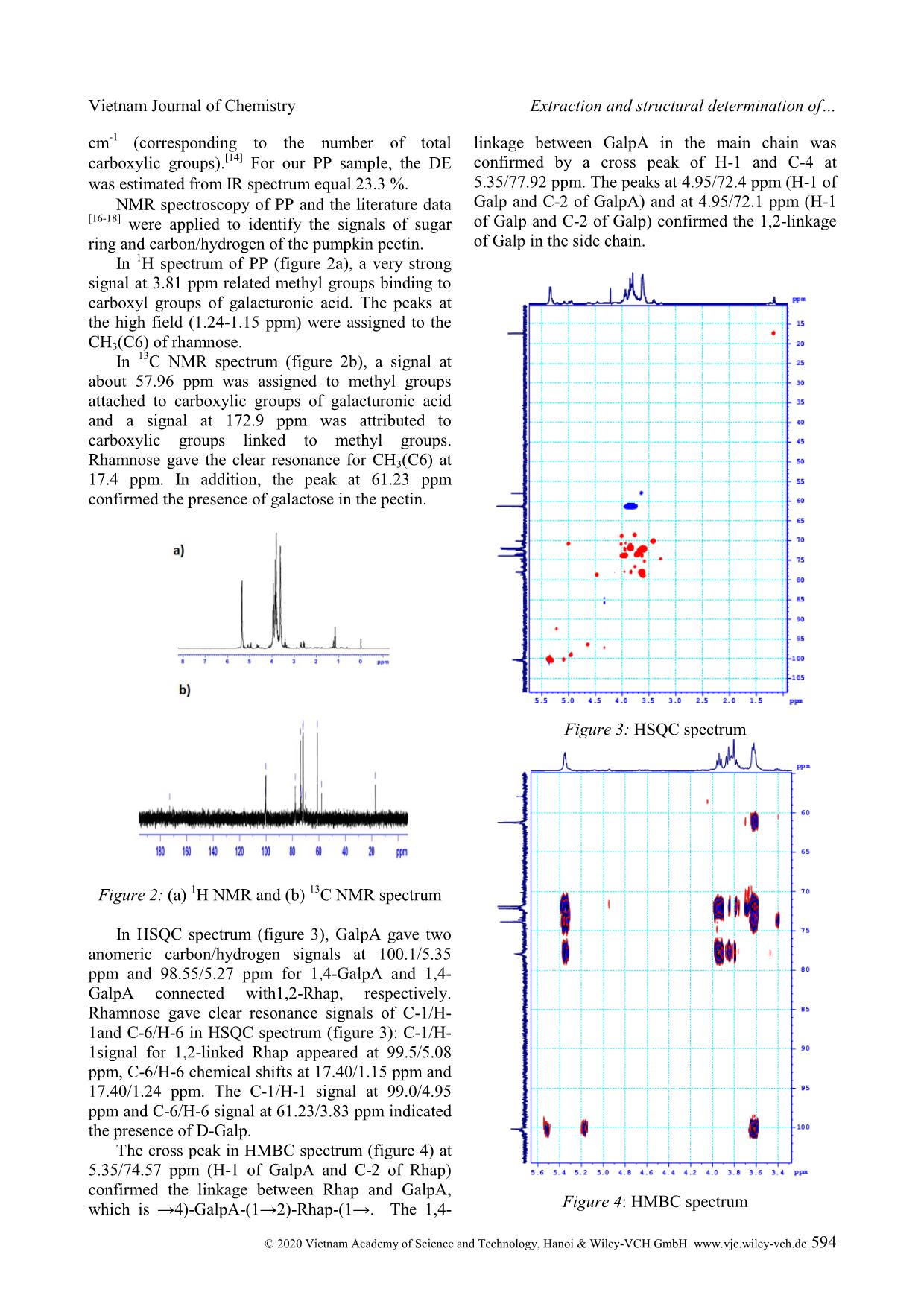
Trang 3
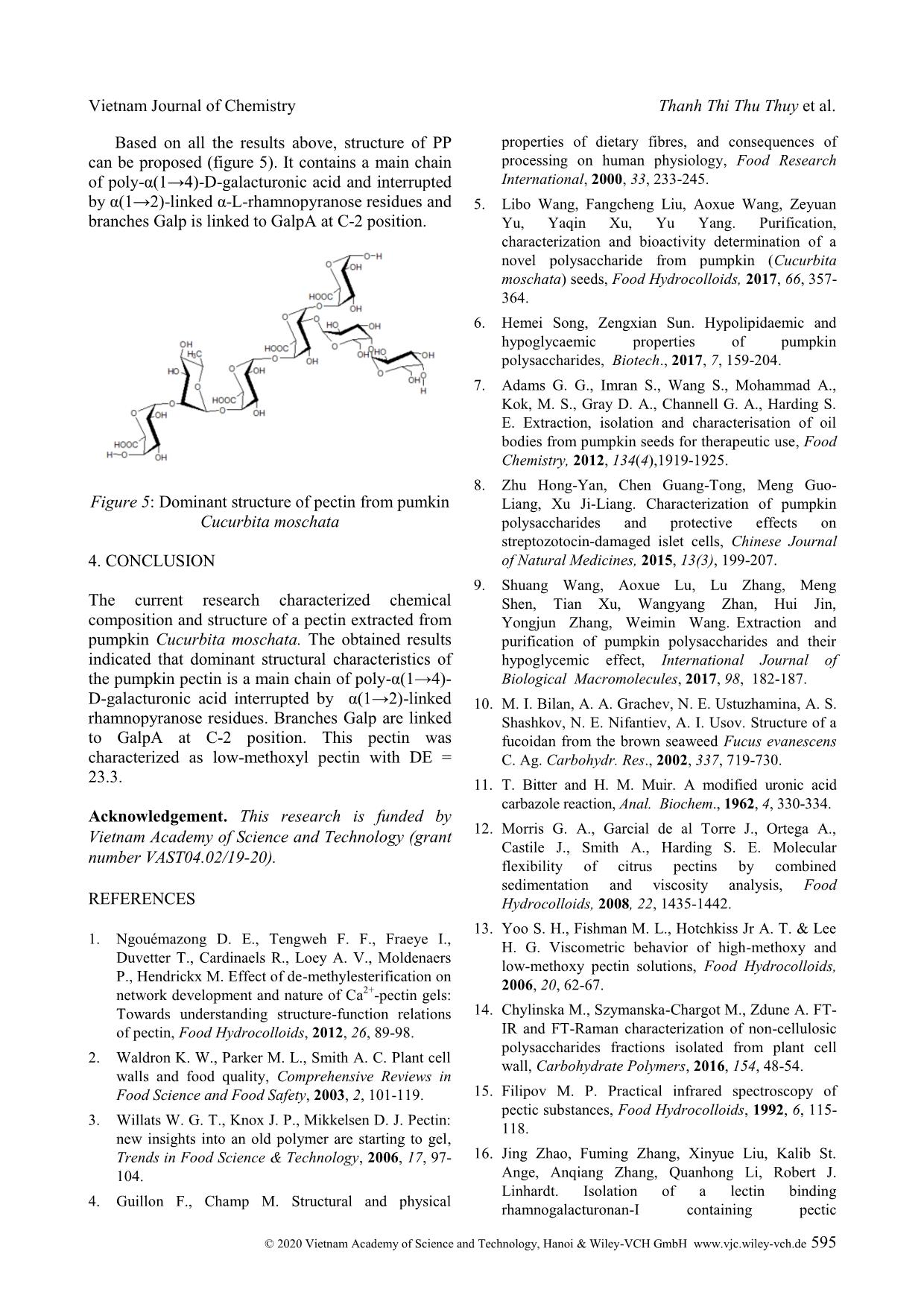
Trang 4
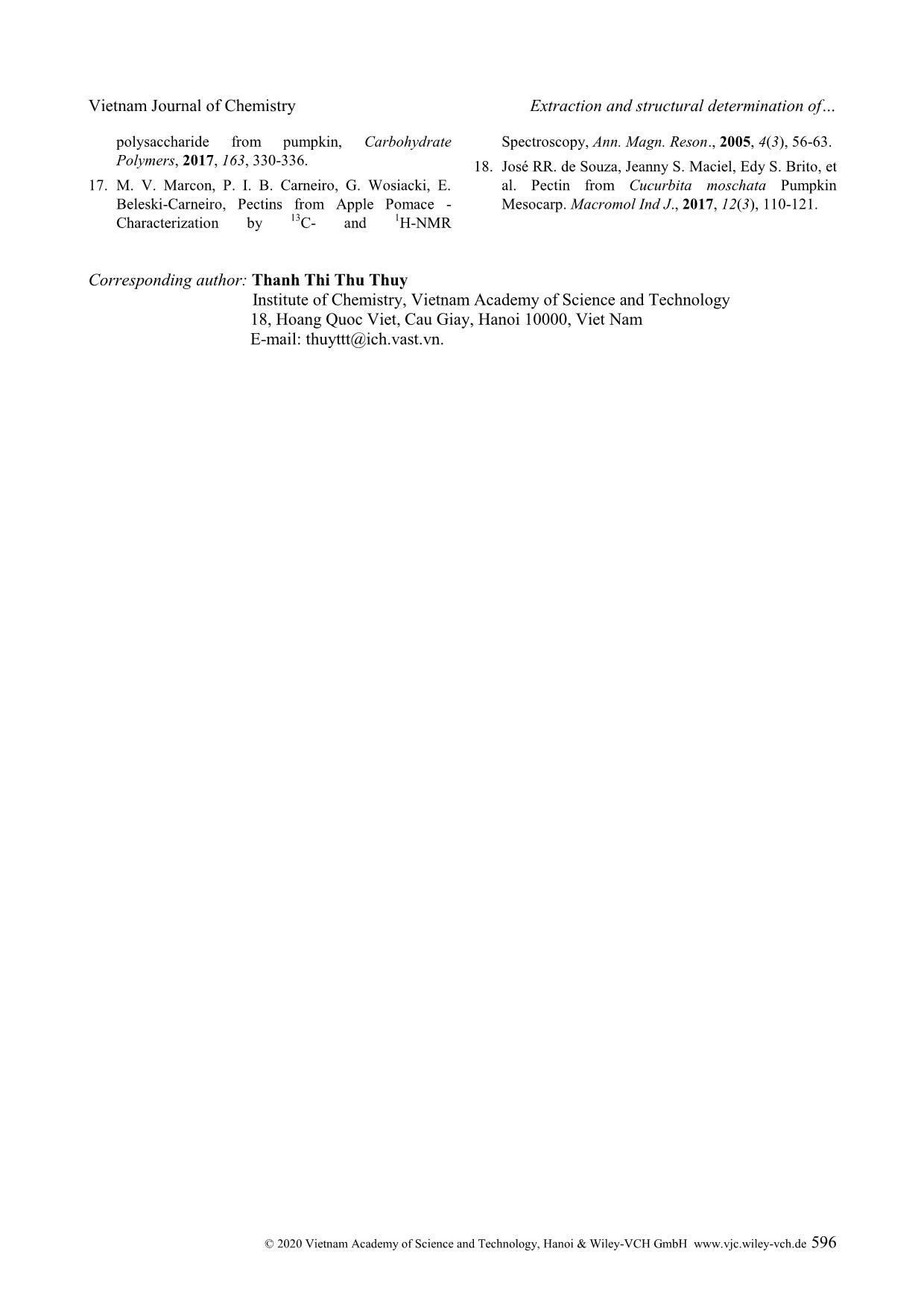
Trang 5
Bạn đang xem tài liệu "Extraction and structural determination of pectin from pumkin Cucurbita moschata", để tải tài liệu gốc về máy hãy click vào nút Download ở trên
Tóm tắt nội dung tài liệu: Extraction and structural determination of pectin from pumkin Cucurbita moschata
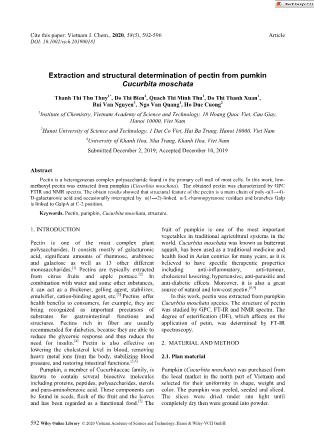
Cite this paper: Vietnam J. Chem., 2020, 58(5), 592-596 Article DOI: 10.1002/vjch.201900181 592 Wiley Online Library © 2020 Vietnam Academy of Science and Technology, Hanoi & Wiley-VCH GmbH Extraction and structural determination of pectin from pumkin Cucurbita moschata Thanh Thi Thu Thuy 1* , Do Thi Bien 2 , Quach Thi Minh Thu 1 , Do Thi Thanh Xuan 1 , Bui Van Nguyen 3 , Ngo Van Quang 1 , Ho Duc Cuong 2 1 Institute of Chemistry, Vietnam Academy of Science and Technology, 18 Hoang Quoc Viet, Cau Giay, Hanoi 10000, Viet Nam 2 Hanoi University of Science and Technology, 1 Dai Co Viet, Hai Ba Trung, Hanoi 10000, Viet Nam 4 University of Khanh Hoa, Nha Trang, Khanh Hoa, Viet Nam Submitted December 2, 2019; Accepted December 10, 2019 Abstract Pectin is a heterogeneous complex polysaccharide found in the primary cell wall of most cells. In this work, low- methoxyl pectin was extracted from pumpkin (Cucurbita moschata). The obtained pectin was characterized by GPC FTIR and NMR spectra. The obtain results showed that structural feature of the pectin is a main chain of poly-α(1→4)- D-galacturonic acid and occasionally interrupted by α(1→2)-linked α-L-rhamnopyranose residues and branches Galp is linked to GalpA at C-2 position. Keywords. Pectin, pumpkin, Cucurbita moschata, structure. 1. INTRODUCTION Pectin is one of the most complex plant polysaccharides. It consists mostly of galacturonic acid, significant amounts of rhamnose, arabinose and galactose as well as 13 other different monosaccharides. [1] Pectins are typically extracted from citrus fruits and apple pomace. [2] In combination with water and some other substances, it can act as a thickener, gelling agent, stabilizer, emulsifier, cation-binding agent, etc. [3] Pectins offer health benefits to consumers, for example, they are being recognized as important precursors of substrates for gastrointestinal functions and structures. Pectins rich in fiber are usually recommended for diabetics, because they are able to reduce the glycemic response and thus reduce the need for insulin. [4] Pectin is also effective on lowering the cholesterol level in blood, removing heavy metal ions from the body, stabilizing blood pressure, and restoring intestinal functions. [5,6] Pumpkin, a member of Cucurbitaceae family, is known to contain several bioactive molecules including proteins, peptides, polysaccharides, sterols and para-aminobenzoic acid. These components can be found in seeds, flesh of the fruit and the leaves and has been regarded as a functional food. [7] The fruit of pumpkin is one of the most important vegetables in traditional agricultural systems in the world. Cucurbita moschata was known as butternut squash, has been used as a traditional medicine and health food in Asian contries for many years, as it is believed to have specific therapeutic properties including anti-inflammatory, anti-tumour, cholesterol lowering, hypertensive, anti-parasitic and anti-diabetic effects. Moreover, it is also a great source of natural and low-cost pectin. [8,9] In this work, pectin was extracted from pumpkin Cucurbita moschata species. The structure of pectin was studied by GPC, FT-IR and NMR spectra. The degree of esterification (DE), which affects on the application of petin, was determined by FT-IR spectroscopy. 2. MATERIAL AND METHOD 2.1. Plan material Pumpkin (Cucurbita moschata) was purchased from the local market in the north part of Vietnam and selected for their uniformity in shape, weight and color. The pumpkin was peeled, seeded and sliced. The slices were dried under sun light until completely dry then were ground into powder. Vietnam Journal of Chemistry Thanh Thi Thu Thuy et al. © 2020 Vietnam Academy of Science and Technology, Hanoi & Wiley-VCH GmbH www.vjc.wiley-vch.de 593 2.2. Extraction and purification of pectin from pumpkin 100 ml of 0.1 M HCl solution was stabilized at 65 °C and after that, 10 g pumpkin powder obtained above was added to the solution and let extracting for 2 hours. After precipitation and washing with ethanol PA (1:4 = solution:ethanol), filtration and freeze-drying, it was obtained 1.2 g of pectin. Crude pectin after purification by dialysis membranes remained 0.69 g of pure pectin (named PP) which was used for further analysis (yield calculated from pumpkin dry powder is 6.9 %). 2.3. Chemical analysis Neutral monosaccharide compositions were elucidated by the method of Bilan et al. [10] Alditol acetate derivatives were prepared by hydrolysis of ulvan sample in 2 M CF3COOH (TFA), at 100 °C for 8 hr, and analyzed by 17AAFW Shimadzu GC-FID. Uronic acid content was determined following the carbazole method using D-glucuronic acid as a standard. [11] 2.4. Gel permeation chromatography (GPC) GPC measurement was performed on an HPLC Agilent 1100 with a refractive index detector RID at 30 o C. The eluent was 1.2 N NaNO3 with flow rate of 1.0 mL/min. The sample concentration was 1mg/ml. Pullulan was used as a standard sample 2.5. IR spectrum FT-IR spectrum of the solid sample in the form of KBr pellets was recorded on a FTIR Affinity-1S Shimadzu spectrometer in the range of 400 cm -1 and 4000 cm -1 . 2.6. NMR spectrum 1D and 2D NMR spectra were recorded on a Bruker AVANCE III 500 MHz spectrometer at 70 °C. The concentration of polymer was 3 mg/ml in a solvent of D2O+1 % CD3COOD. DSS was used as an internal standard. The water signal was suppressed by a presaturation sequence at the water signal frequency. 3. RESULTS AND DISCUSSION The weight averaged molecular weight (Mw) and the number averaged molecular weight (Mn) of PP determined by GPC. Like other native polysaccharides, the molecular weight distribution of PP is high polydisperse with Mw/Mn = 2.08 and Mw = 2.4 104 g/mol. Published molar mass values for pectins from citrus fruits and apple pomace ranges from 1.4 105 to 2.3 105 g/mol, So, the molar mass of our pumkin pectin is lower than that of pectin from other resources. [12,13] The results of chemical analysis showed that the pectin was composed of rhamnose, galacturonic acid, galactose, arabinose and xylose with a weight ratio of GalA:Gal:Rham:Ara:Xyl = 45.5:30.2:17.2: 4.1:3.0. Thus, galacturonic acid was the most abundant in the pectin followed by galactose and rhamnose. Figure 1: FTIR spectrum of polysaccharide from pumpkin The FT-IR spectrum (figure 1) of PP showed the characteristic absorption bands of pectin. The strong and broad absorption area at 3319 cm -1 was attributed to the O-H stretching vibration due to intermolecular and intramolecular hydrogen bonds The absorption at 2927 cm -1 was assigned to the C-H stretching vibration.The absorption at 1739 cm -1 was assigned to methyl ester group. A band at 1597 cm -1 coupled with another band at 1406 cm -1 were from the asymmetric and symmetric stretching vibration of the carboxylate groups, respectively, confirming the presence of uronic acid. Specific band in the 1200-1000 cm -1 region is dominated by ring vibrations overlapped with stretching vibrations of (C-OH) side groups and the (C-O-C) glycosidic band vibration, which is unique to pectin polysaccharide. [14,15] Pectins are classified as low methoxyl (LM) or high methoxyl (HM) according to their degree of esterification. The degree of esterification (DE) affects on the application of petin and it is defined as follows: (number of esterified carboxylic groups/number of total carboxylic groups) x 100. In IR spectrum, DE is inferred from the ratio of the area of the band at 1739 cm -1 (corresponding to the number of esterified carboxylic groups) over the sum of the areas of the bands at 1739 cm -1 and 1597 Vietnam Journal of Chemistry Extraction and structural determination of © 2020 Vietnam Academy of Science and Technology, Hanoi & Wiley-VCH GmbH www.vjc.wiley-vch.de 594 cm -1 (corresponding to the number of total carboxylic groups). [14] For our PP sample, the DE was estimated from IR spectrum equal 23.3 %. NMR spectroscopy of PP and the literature data [16-18] were applied to identify the signals of sugar ring and carbon/hydrogen of the pumpkin pectin. In 1 H spectrum of PP (figure 2a), a very strong signal at 3.81 ppm related methyl groups binding to carboxyl groups of galacturonic acid. The peaks at the high field (1.24-1.15 ppm) were assigned to the CH3(C6) of rhamnose. In 13 C NMR spectrum (figure 2b), a signal at about 57.96 ppm was assigned to methyl groups attached to carboxylic groups of galacturonic acid and a signal at 172.9 ppm was attributed to carboxylic groups linked to methyl groups. Rhamnose gave the clear resonance for CH3(C6) at 17.4 ppm. In addition, the peak at 61.23 ppm confirmed the presence of galactose in the pectin. Figure 2: (a) 1 H NMR and (b) 13 C NMR spectrum In HSQC spectrum (figure 3), GalpA gave two anomeric carbon/hydrogen signals at 100.1/5.35 ppm and 98.55/5.27 ppm for 1,4-GalpA and 1,4- GalpA connected with1,2-Rhap, respectively. Rhamnose gave clear resonance signals of C-1/H- 1and C-6/H-6 in HSQC spectrum (figure 3): C-1/H- 1signal for 1,2-linked Rhap appeared at 99.5/5.08 ppm, C-6/H-6 chemical shifts at 17.40/1.15 ppm and 17.40/1.24 ppm. The C-1/H-1 signal at 99.0/4.95 ppm and C-6/H-6 signal at 61.23/3.83 ppm indicated the presence of D-Galp. The cross peak in HMBC spectrum (figure 4) at 5.35/74.57 ppm (H-1 of GalpA and C-2 of Rhap) confirmed the linkage between Rhap and GalpA, which is →4)-GalpA-(1→2)-Rhap-(1→. The 1,4- linkage between GalpA in the main chain was confirmed by a cross peak of H-1 and C-4 at 5.35/77.92 ppm. The peaks at 4.95/72.4 ppm (H-1 of Galp and C-2 of GalpA) and at 4.95/72.1 ppm (H-1 of Galp and C-2 of Galp) confirmed the 1,2-linkage of Galp in the side chain. Figure 3: HSQC spectrum Figure 4: HMBC spectrum Vietnam Journal of Chemistry Thanh Thi Thu Thuy et al. © 2020 Vietnam Academy of Science and Technology, Hanoi & Wiley-VCH GmbH www.vjc.wiley-vch.de 595 Based on all the results above, structure of PP can be proposed (figure 5). It contains a main chain of poly-α(1→4)-D-galacturonic acid and interrupted by α(1→2)-linked α-L-rhamnopyranose residues and branches Galp is linked to GalpA at C-2 position. Figure 5: Dominant structure of pectin from pumkin Cucurbita moschata 4. CONCLUSION The current research characterized chemical composition and structure of a pectin extracted from pumpkin Cucurbita moschata. The obtained results indicated that dominant structural characteristics of the pumpkin pectin is a main chain of poly-α(1→4)- D-galacturonic acid interrupted by α(1→2)-linked rhamnopyranose residues. Branches Galp are linked to GalpA at C-2 position. This pectin was characterized as low-methoxyl pectin with DE = 23.3. Acknowledgement. This research is funded by Vietnam Academy of Science and Technology (grant number VAST04.02/19-20). REFERENCES 1. Ngouémazong D. E., Tengweh F. F., Fraeye I., Duvetter T., Cardinaels R., Loey A. V., Moldenaers P., Hendrickx M. Effect of de-methylesterification on network development and nature of Ca 2+ -pectin gels: Towards understanding structure-function relations of pectin, Food Hydrocolloids, 2012, 26, 89-98. 2. Waldron K. W., Parker M. L., Smith A. C. Plant cell walls and food quality, Comprehensive Reviews in Food Science and Food Safety, 2003, 2, 101-119. 3. Willats W. G. T., Knox J. P., Mikkelsen D. J. Pectin: new insights into an old polymer are starting to gel, Trends in Food Science & Technology, 2006, 17, 97- 104. 4. Guillon F., Champ M. Structural and physical properties of dietary fibres, and consequences of processing on human physiology, Food Research International, 2000, 33, 233-245. 5. Libo Wang, Fangcheng Liu, Aoxue Wang, Zeyuan Yu, Yaqin Xu, Yu Yang. Purification, characterization and bioactivity determination of a novel polysaccharide from pumpkin (Cucurbita moschata) seeds, Food Hydrocolloids, 2017, 66, 357- 364. 6. Hemei Song, Zengxian Sun. Hypolipidaemic and hypoglycaemic properties of pumpkin polysaccharides, Biotech., 2017, 7, 159-204. 7. Adams G. G., Imran S., Wang S., Mohammad A., Kok, M. S., Gray D. A., Channell G. A., Harding S. E. Extraction, isolation and characterisation of oil bodies from pumpkin seeds for therapeutic use, Food Chemistry, 2012, 134(4),1919-1925. 8. Zhu Hong-Yan, Chen Guang-Tong, Meng Guo- Liang, Xu Ji-Liang. Characterization of pumpkin polysaccharides and protective effects on streptozotocin-damaged islet cells, Chinese Journal of Natural Medicines, 2015, 13(3), 199-207. 9. Shuang Wang, Aoxue Lu, Lu Zhang, Meng Shen, Tian Xu, Wangyang Zhan, Hui Jin, Yongjun Zhang, Weimin Wang. Extraction and purification of pumpkin polysaccharides and their hypoglycemic effect, International Journal of Biological Macromolecules, 2017, 98, 182-187. 10. M. I. Bilan, A. A. Grachev, N. E. Ustuzhamina, A. S. Shashkov, N. E. Nifantiev, A. I. Usov. Structure of a fucoidan from the brown seaweed Fucus evanescens C. Ag. Carbohydr. Res., 2002, 337, 719-730. 11. T. Bitter and H. M. Muir. A modified uronic acid carbazole reaction, Anal. Biochem., 1962, 4, 330-334. 12. Morris G. A., Garcial de al Torre J., Ortega A., Castile J., Smith A., Harding S. E. Molecular flexibility of citrus pectins by combined sedimentation and viscosity analysis, Food Hydrocolloids, 2008, 22, 1435-1442. 13. Yoo S. H., Fishman M. L., Hotchkiss Jr A. T. & Lee H. G. Viscometric behavior of high-methoxy and low-methoxy pectin solutions, Food Hydrocolloids, 2006, 20, 62-67. 14. Chylinska M., Szymanska-Chargot M., Zdune A. FT- IR and FT-Raman characterization of non-cellulosic polysaccharides fractions isolated from plant cell wall, Carbohydrate Polymers, 2016, 154, 48-54. 15. Filipov M. P. Practical infrared spectroscopy of pectic substances, Food Hydrocolloids, 1992, 6, 115- 118. 16. Jing Zhao, Fuming Zhang, Xinyue Liu, Kalib St. Ange, Anqiang Zhang, Quanhong Li, Robert J. Linhardt. Isolation of a lectin binding rhamnogalacturonan-I containing pectic Vietnam Journal of Chemistry Extraction and structural determination of © 2020 Vietnam Academy of Science and Technology, Hanoi & Wiley-VCH GmbH www.vjc.wiley-vch.de 596 polysaccharide from pumpkin, Carbohydrate Polymers, 2017, 163, 330-336. 17. M. V. Marcon, P. I. B. Carneiro, G. Wosiacki, E. Beleski-Carneiro, Pectins from Apple Pomace - Characterization by 13 C- and 1 H-NMR Spectroscopy, Ann. Magn. Reson., 2005, 4(3), 56-63. 18. José RR. de Souza, Jeanny S. Maciel, Edy S. Brito, et al. Pectin from Cucurbita moschata Pumpkin Mesocarp. Macromol Ind J., 2017, 12(3), 110-121. Corresponding author: Thanh Thi Thu Thuy Institute of Chemistry, Vietnam Academy of Science and Technology 18, Hoang Quoc Viet, Cau Giay, Hanoi 10000, Viet Nam E-mail: thuyttt@ich.vast.vn.
File đính kèm:
 extraction_and_structural_determination_of_pectin_from_pumki.pdf
extraction_and_structural_determination_of_pectin_from_pumki.pdf

